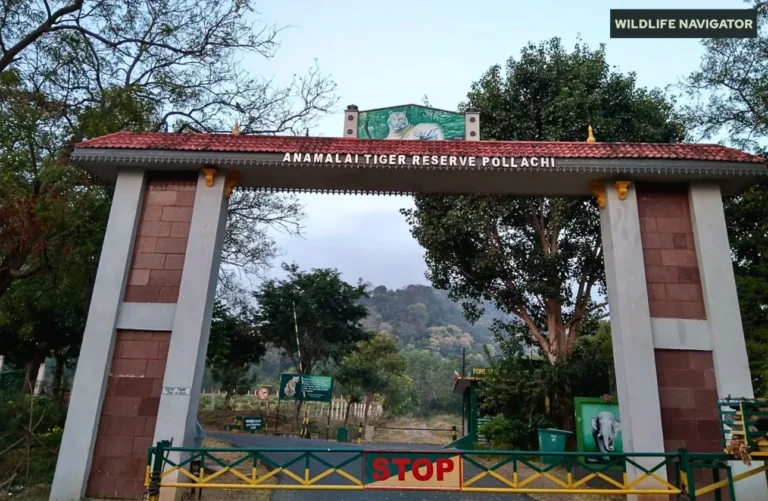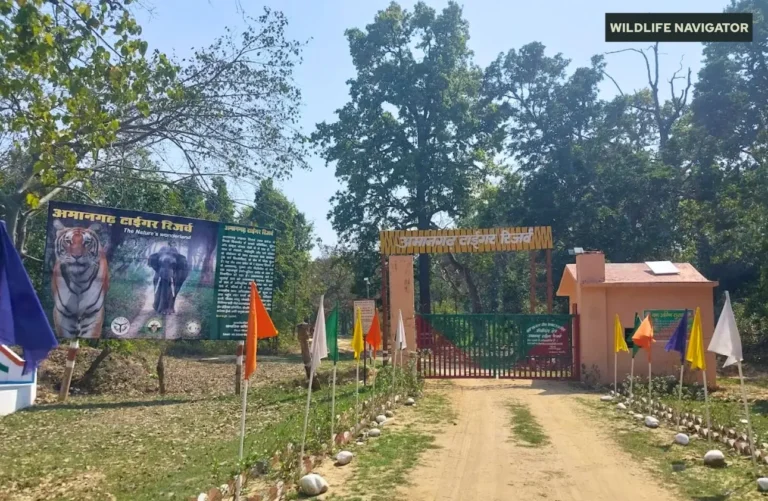Ranipur Tiger Reserve: Explore Uttar Pradesh’s Hidden Wildlife Haven

Ranipur Tiger Reserve is one of India’s newest and most promising protected areas, located in the Chitrakoot district of Uttar Pradesh. Officially notified in 2022, it became the 54th Tiger Reserve of India under the prestigious Project Tiger initiative. Spanning across the Vindhyan landscape, Ranipur serves as a vital link between the Panna Tiger Reserve in Madhya Pradesh and other forested regions, offering a safe corridor for tigers and other wildlife species.
This reserve holds immense ecological importance, featuring rugged terrain, rocky outcrops, and a mix of dry deciduous forests. Its establishment has not only expanded tiger conservation efforts in north-central India but also brought new opportunities for eco-tourism and local livelihoods.
Ranipur is still in the early stages of development, which makes it an exciting destination for wildlife enthusiasts seeking raw, untouched wilderness. The reserve’s quiet beauty, combined with its growing population of fauna and birdlife, makes it a promising addition to India’s network of tiger reserves and a potential hotspot for conservation-driven tourism.
History and Establishment
The idea of creating Ranipur Tiger Reserve had been under discussion for several years due to the rich wildlife presence and strategic location of the Ranipur Wildlife Sanctuary. Originally declared as a wildlife sanctuary in 1977, the area was recognised for its potential to support tiger conservation because of its proximity to Panna Tiger Reserve in Madhya Pradesh. After extensive surveys and ecological assessments, the Government of India officially declared Ranipur as the 54th Tiger Reserve in October 2022 under the Project Tiger initiative.
The formation of this reserve marked a significant milestone for Uttar Pradesh, as it became the state’s fourth tiger reserve, after Dudhwa, Pilibhit, and Amangarh. The decision aimed to strengthen tiger conservation across the Vindhyan range while promoting balanced coexistence between wildlife and local communities.
Ranipur Tiger Reserve covers both the core area of Ranipur Wildlife Sanctuary and the adjoining forest divisions that serve as the buffer zone. The reserve is expected to play a crucial role in creating a continuous habitat corridor between the forests of Chitrakoot and Panna, aiding tiger movement and genetic exchange. Its establishment highlights India’s ongoing commitment to expanding tiger habitats and ensuring long-term ecological security for both wildlife and people.
Geography and Landscape
Location and Area
Ranipur Tiger Reserve is situated in the Chitrakoot district of Uttar Pradesh, covering an area of approximately 529.36 square kilometres. Out of this, around 230 sq km forms the core area, while the remaining 299 sq km acts as the buffer zone. The reserve lies along the northern part of the Vindhyan hill range, sharing ecological continuity with Panna Tiger Reserve in Madhya Pradesh.
Topography and Terrain
The landscape is characterised by rocky plateaus, dry valleys, steep cliffs, and mixed forests. The terrain varies from rugged hills to flat plains, creating diverse habitats suitable for a range of wildlife species. Seasonal streams and small waterholes provide essential water sources for animals, especially during the dry months.
Climate and Seasons
Ranipur experiences a tropical climate with distinct summer, monsoon, and winter seasons. Summers (March–June) are hot and dry, while monsoon (July–September) brings moderate rainfall that rejuvenates the forest. Winters (October–February) are pleasant and ideal for wildlife viewing.
Significance of the Landscape
The Vindhyan ecosystem supports dry deciduous vegetation and serves as a vital wildlife corridor linking central and northern India. The diverse geography not only supports tigers but also helps maintain ecological balance by sustaining herbivores, birds, and smaller carnivores.
Flora of Ranipur Tiger Reserve
Ranipur Tiger Reserve is covered predominantly by dry deciduous forests, typical of the Vindhyan ecosystem. The vegetation here plays a crucial role in maintaining ecological balance by providing shelter, food, and breeding grounds for wildlife species, especially herbivores and tigers. The floral diversity of Ranipur includes a mix of trees, shrubs, grasses, and medicinal plants, all adapted to withstand the region’s dry conditions.
Major Types of Flora
1. Dominant Tree Species:
- Salai (Boswellia serrata)
- Tendu (Diospyros melanoxylon)
- Mahua (Madhuca longifolia)
- Palash (Butea monosperma)
- Khair (Acacia catechu)
- Ber (Ziziphus mauritiana)
2. Shrubs and Bushes:
- Lantana camara (invasive but common)
- Carissa carandas (Karonda)
- Ziziphus nummularia
- Adhatoda vasica (used in traditional medicine)
3. Grasses and Ground Cover:
- Cymbopogon martinii (Palmarosa grass)
- Heteropogon contortus
- Desmostachya bipinnata
These grasses form the base of the food chain, sustaining herbivores like deer and antelopes.
4. Medicinal and Useful Plants:
Local communities depend on several plant species for herbal medicine, fuelwood, and fodder, highlighting the socio-ecological importance of Ranipur’s flora.
Overall, the floral composition reflects a resilient ecosystem adapted to dry conditions while supporting a wide range of fauna and maintaining biodiversity.
Fauna and Wildlife of Ranipur Tiger Reserve
Ranipur Tiger Reserve supports a diverse array of wildlife, reflecting the ecological richness of the Vindhyan forests. Although tiger sightings are still rare due to the reserve’s recent establishment, the region offers immense potential for tiger habitation and movement between Panna Tiger Reserve in Madhya Pradesh and adjoining forest patches in Uttar Pradesh. The area’s varied landscape of hills, valleys, and woodlands provides habitats for numerous mammals, birds, reptiles, and insects.
Major Mammals Found in Ranipur
- Bengal Tiger (Panthera tigris tigris): Occasional movements have been recorded from neighboring reserves.
- Leopard (Panthera pardus): The most dominant large predator currently present.
- Sloth Bear (Melursus ursinus): Often found in rocky terrains and caves.
- Indian Wolf (Canis lupus pallipes) and Jackal (Canis aureus): Common across open grasslands.
- Spotted Deer (Axis axis) and Sambar Deer (Rusa unicolour): Key prey species for big cats.
- Blue Bull or Nilgai (Boselaphus tragocamelus): Frequently sighted in buffer zones.
- Wild Boar, Indian Fox, and Langur: Play important ecological roles in the reserve.
Birdlife
Ranipur is an emerging haven for birdwatchers, hosting both resident and migratory birds. Common sightings include:
- Peafowl, Partridges, Junglefowl, and Drongos
- Black-shouldered Kite, Serpent Eagle, and Indian Roller
- Seasonal visitors such as Bee-eaters and Flycatchers
Reptiles and Others
- Monitor Lizard, Indian Cobra, Python, and Rat Snake are frequently observed.
- Numerous amphibians, butterflies, and insects thrive during the monsoon, enhancing biodiversity.
Ecological Role
The balanced predator-prey relationship, combined with a healthy mix of herbivores, carnivores, and scavengers, helps maintain a dynamic ecosystem. Conservation efforts aim to strengthen the tiger population and restore natural habitats to ensure long-term wildlife sustainability.
Best Time to Visit Ranipur Tiger Reserve
The best time to visit Ranipur Tiger Reserve is from November to April, when the weather is pleasant and wildlife sightings are more frequent. During this period, the forest remains vibrant with lush greenery after the monsoon and moderate temperatures ideal for safaris and outdoor exploration.
Seasonal Highlights:
- Winter (November–February): The most comfortable season for safaris, with cool mornings and mild afternoons. Visibility is excellent, making it easier to spot herbivores and birds near water sources. Migratory birds also arrive during this time, offering a rich birdwatching experience.
- Early Summer (March–April): As temperatures rise, animals often gather around remaining water bodies, increasing the chance of spotting predators like leopards or tigers.
- Monsoon (July–September): The reserve receives moderate rainfall, rejuvenating the forest. However, safaris are usually restricted due to slippery terrain and breeding activities of wildlife.
Visitors should avoid the peak summer months (May–June) when temperatures can exceed 40°C, making it uncomfortable for travel and wildlife movement.
For the best experience, plan safaris early in the morning or late in the afternoon when animals are most active and the lighting is perfect for photography.
Safari and Visitor Experience
Ranipur Tiger Reserve offers a raw and authentic wildlife experience, ideal for travellers seeking offbeat destinations. As a newly established reserve, safari tourism is still developing, which adds to its charm for those who prefer quiet forest trails over crowded parks.
Types of Safaris and Activities
- Jeep Safari: The primary mode of exploring Ranipur’s rugged terrain. Visitors can enjoy guided jeep rides through dense forests and open grasslands, spotting deer, birds, and occasionally predators.
- Guided Nature Walks: Local forest guides often lead short treks around designated buffer zones, offering a closer look at vegetation, animal tracks, and birdlife.
- Birdwatching Tours: The Vindhyan landscape attracts numerous resident and migratory species, making Ranipur a promising site for birding enthusiasts.
Entry Points and Access
The main access point is through Ranipur Wildlife Sanctuary Gate near Chitrakoot, which can be easily reached by road from Banda and Prayagraj. The Uttar Pradesh Forest Department manages entry timings and safari permits, and visitors are advised to book in advance once official safari operations are fully established.
Visitor Tips
- Opt for early morning or late afternoon safaris for the best sightings.
- Carry binoculars, water, and light snacks.
- Follow eco-tourism guidelines — avoid loud noises, littering, and off-route driving.
Ranipur promises a tranquil safari experience where visitors can immerse themselves in untouched wilderness and witness the slow revival of a flourishing tiger habitat.
Conservation Efforts and Challenges
Ranipur Tiger Reserve represents a significant step in expanding tiger conservation across northern India. Since its declaration in 2022, efforts have focused on habitat restoration, prey base improvement, and strengthening anti-poaching measures. The Uttar Pradesh Forest Department and National Tiger Conservation Authority (NTCA) are working together to develop infrastructure, deploy camera traps, and monitor wildlife movement from nearby tiger populations like those in Panna.
Local communities are being engaged through eco-development programs that promote sustainable livelihoods such as nature guiding, handicrafts, and eco-tourism services. This community participation is key to reducing dependence on forest resources.
However, challenges remain — including human-wildlife conflict, habitat fragmentation, and limited water sources during summer. Continuous monitoring and long-term management plans aim to address these issues and establish Ranipur as a secure and thriving habitat for tigers and other species.
How to Reach Ranipur Tiger Reserve
Ranipur Tiger Reserve is located in Chitrakoot district, Uttar Pradesh, and is well connected by road and rail to major cities in northern India. Despite being relatively remote, it’s accessible for visitors planning a wildlife trip combined with nearby cultural destinations.
By Air:
The nearest airport is Prayagraj Airport (approximately 120 km), offering regular flights from Delhi, Lucknow, and other major cities. Khajuraho Airport (around 170 km) in Madhya Pradesh is another good option for travellers coming from central India.
By Train:
The closest railway station is Chitrakoot Dham (Karwi), situated about 30 km from the reserve. It is well linked to major cities like Delhi, Lucknow, and Varanasi through regular train services.
By Road:
Ranipur can be easily reached via National Highway 35 (NH-35). Buses and taxis are available from nearby towns such as Banda (60 km), Prayagraj (120 km), and Satna (100 km). Roads are generally in good condition, offering a comfortable drive through scenic rural landscapes.
Visitors are advised to confirm safari entry gates and timings in advance with the Uttar Pradesh Forest Department, as Ranipur’s tourism facilities are still expanding.
Conclusion
Ranipur Tiger Reserve is emerging as a promising wildlife destination in northern India, offering a unique opportunity to witness untamed forests, diverse flora, and rich fauna. As a newly established reserve, it plays a vital role in strengthening tiger conservation, connecting habitats between Panna and other forested regions, and providing a safe corridor for wildlife.
The reserve’s rugged landscapes, dry deciduous forests, and thriving biodiversity make it an ideal spot for eco-tourism, safari adventures, and birdwatching. Visitors can enjoy a tranquil experience while supporting ongoing conservation efforts.
With continued protection, habitat management, and community involvement, Ranipur Tiger Reserve is set to become a key site for tiger population recovery and biodiversity preservation. Exploring this reserve not only allows travellers to witness India’s natural heritage but also contributes to the long-term sustainability of one of the country’s most iconic species—the Bengal tiger.





